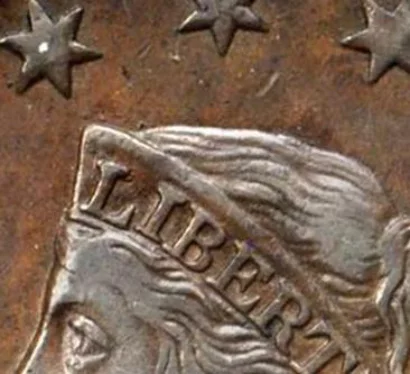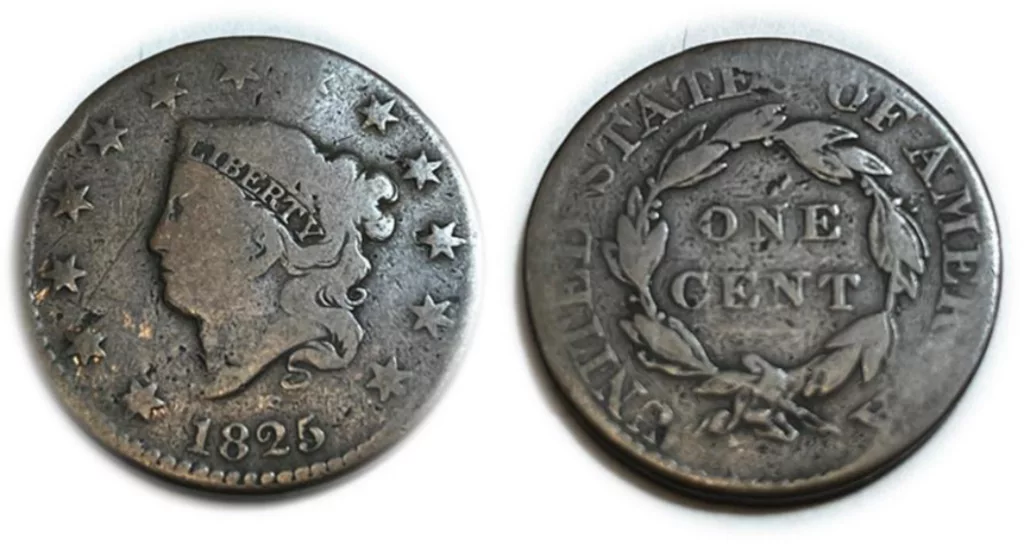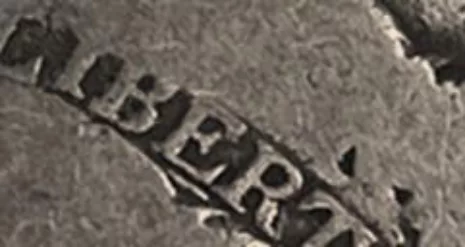TOM DECK’S REMARKABLE DISCOVERY OF ANDREWS’ RARE
By Ron Gammill
If you are a large cent collector and you collect the middle date series (1816-1839), you will run up against several very difficult varieties that you might just dream of adding to your collection because of their rarity and cost. In fact, you might be looking for a variety that was only verified/re-discovered in 2011 by my good friend, fellow collector and native Michigander (Lansing), Tom Deck.
I have been collecting these copper prizes for about 30 years, and I have always thought that the 1825 N-5 (R-7), the 1827 N-12 (R-7), the 1830 N9 (R-6+), the 1835 N-4 (R-6/7), the 1835 N-11 (R-6/7), the 1835 N-18 (R-6/7), the 1838 N-14 (w/cud R-7) and the 1839 N-15 (R-7) would be difficult, if not impossible, to find and more importantly afford.
In reality, there is one more trophy, the 1834 N-7, which will likely never find a place in my collection because of rarity (seven known) and price (unless Martha and I hit the lottery)!
Over the last 30 years, I have surprised myself because I have managed, with the help of dealers and collectors like Tom, Steve Carr, Tom Reynolds and Doug Bird, to find all of these die varieties with the exception of the 1825 A-5 (later noted as N-5 by Newcomb) and, of course, the 1834 N-7.
What’s even more interesting in retrospect, when I began seriously collecting the middle dates, the Newcomb-5 (so designated in 1944) was considered a non-existent variety. In fact, in John Wright’s, The Cent Book, 1816 –1839, published in 1992, he stated as follows:
“There is NO Number 5. The coin listed by Frank Andrews as his number 5 (4e) is an early-state number 10. The specific coin from which Andrews made his “A-5” listing is a boldly-struck number 10, later in the Blaisdell collection, so the “long-lost Andrews 5 is a fiction—one of Andrews’ few mistakes.”

Figure I
Obverse N-4 & Reverse N-10
Finest known 1825 N-5 (ANACS F-15)
Discovered on eBay in January of 2022
Sold for $171.01
The prized 1825 N-5 variety was first catalogued by Frank D. Andrews in his 1883 book, An Arrangement of United States Copper Cents 1816-1857, for the Assistance of Collectors (2nd edition). He identified it then as a pairing of his A4 (Andrews Die 4) obverse with his E reverse.
When Howard Newcomb wrote his landmark, United States Copper Cents 1816-1857, in 1944, he used the work of Andrews as his basis and, at the same time, expanded on both descriptions and listings. Newcomb worked directly from a second edition (1883) copy of Andrews’ work, noting varieties he was able to confirm and establish rarity. Newcomb used his own vast collection of large cents as well as coins from other advanced collections.
Noted collector George Clapp wrote the foreword to Newcomb’s work and stated, “Newcomb has been able to eliminate varieties that no one, in recent years at least, has been able to find.” That statement pertains directly to the 1825 A-5, among others. Newcomb was able to confirm each one of Andrews’ cents of 1825, except for Andrews’ A-5. He simply stated in his book that “Andrews’ A-5 is unknown to me.”
Newcomb did not say that the A-5 did not exist, but that is how it has been interpreted by the entire large cent community. I believe we can call this interpretation an example of “conventional wisdom,”
unfortunately, based on one man’s observation and accepted by the entire community.
As stated above, this was the consensus of the entire large cent community until December 2011, 67 years after Newcomb penned his work, when Tom Deck rediscovered Andrews’ long lost 1825 A-5 on eBay. How did Tom manage to do that? Was he actively looking for Newcomb’s non-extent N-5?
As I was preparing this article, I decided to give Tom a call and ask what the circumstances were leading up to his incredible discovery. Tom said that he had won an 1825 N-4 in an ebay auction but when it arrived and he had an opportunity to examine it more closely. He felt that something wasn’t quite right!
Specifically, while the N-4 obverse die looked to be correct, the reverse die was not matching, i.e., the leaf under the “F” in “OF” did not match what he thought it should. The reverse die of the N-4 variety should have a leaf placement of SPC (slightly past center, see Figure II) but that was not
what Tom was seeing. His coin showed that leaf placement at NC (near center, see
Figure III)’ which was not consistent with the N-4 reverse!

N-4 Rev. Long F with leaf SPC

N-10 Rev. Long F with leaf NC
In fact, what he was seeing appeared to be the reverse die that Andrews referred to as his E die (Newcomb’s N-10). All other leaf positions were consistent with that assignment. The leaf under “D” in UNITED is centered, the final “S” in STATES is past center, the “Long F” in OF with the leaf near center, and the “C” in AMERICA which is slightly past center, are all key elements of reverse die E (N-10). Also, consistent with that die, the entire legend is pushed against the dentils. For these details, see Figure I.
However, the determining factor is a small die chip inside the leaf just left of the “O” in ONE and below the berry (see Figure IV). That die chip definitively identifies Andrews reverse die E.
The date on the N-4 obverse is fairly compact with the “5” practically below the lowest curl (see Figure V). The “key” to identifying this obverse die is noting the strong coronet baseline below the letter “E” in LIBERTY (see Figure VI) and the positioning of the “1” above the two dentils beneath and the “5” centered above a single dentil.



Tom’s 1825 had the Andrews’ A4 obverse and Andrews’ E reverse…the die pairing for the long missing Andrews’ A5 or, as it has become known, as the Newcomb N-5.What a serendipitous discovery! Tom’s discovery coin is illustrated below.
Tom Deck’s 1825 A-5 Discovery Coin

Several months ago, I was having my morning coffee watching the morning news, when I received an email from Tom containing a group of large cents from various collectors that he had for sale. The first thing I noticed was that there was an 1825 N-5 listed. Literally, without thinking, I quickly hit the buy button and won the coin, knowing that it was most likely only the 17th or 18th known. It is pictured below and grades G-6 (See FigureVII).

Gammill’s Andrews’ A-5
The key elements for attribution are clear. The reverse is the N-10 (John Wright’s book) with the “Long F” and the leaf position at NC (see Figure VIII), and all other leaf positions are correct.


The important die chip to the left of the leaf next to the ‘O’ in ONE is clearly visible in. On the obverse, we have the compact date with the correct positional relationship between the “5” and the lower curl, and we clearly have the line under the “E” in LIBERTY (see Figures X and XI). All is well, I have confirmed the attribution of my Andrews’ 1825 A-5 thanks for Tom Deck’s keen eyes and expertise.


If you are a large cent collector and want to try and “cherry pick” an N-5, here are some suggestions:
First, if you are looking at unattributed 1825 large cents:
- Check the reverses first and look for the “Long F.” It is only found on N-2, N-4, N-5,and N-10. N-2 and N-4 have a leaf position SPC! Only N-5 and N-10 have the “NC” placement.
- If you have the “Long F” and the leaf position at “NC,” immediately go the obverse because you have now narrowed it down to two obverses: the N-5 (obverse die of N-4, see Figure V) and the N-10 obverse (see Figure XII). Look for the line under the “E”in LIBERTY. If it’s there, you are headed in the right direction for the N-5! Next, to confirm this obverse, check for the narrow date, the positional relationships between the “1” and the dentils below, and the alignment of the “5” with the curl above. If all matches, you have possession of the famous Andrews 1825A-5.
If you are looking at attributed 1825 issues:
- Look at the N-4s first and make sure they have the correct attribution for the N-4 obverse (see Figure V), then check the reverse. If the reverse has the “Long F,” leaf position at “NC,” and the die chip to the left of the leaf next to the “O” in ONE (see Figure IV), you have found an Andrews’ 1825 A-5, existing as a misattributed N-4. This is what Tom found.
- Also, look at the N-10s and make sure the reverse die has the correct attribution. Then check to be sure the N-10 obverse is correct. That obverse has a wide date and is easily distinguished from the narrow date found on the N-5 (see Figure V). If you find a labeled N-10with a narrow date (two dentils beneath the “1”), a strong line under the “E” and the “1” and “5” in the date correspond to Figure V, congratulations, you have found an Andrews’ 1825A-5. And, you might have in your hand the 19th known example with a price that I’ll just bet will make you happy!
Finally, the correct nomenclature for this rare and highly coveted 1825 variety, in my opinion, is “Andrews’ 1825 A-5.” Technically, the “Newcomb N-5 was non-existent!” Maybe we should identify it as the “Andrews/Deck A-5!” You know, I don’t believe Mr. Andrews would mind this attribution in the least!

N-10 Obverse Date

N-5 (N-4 Obverse)
This is Tom Deck’s website: LargeCents.net
Tom has remarkable coin listings numerous times during the year. You will find Early, Middle, and Late Date Half Cents and Large Cents. You will occasionally find Conder tokens as well. Tom is very knowledgeable, has excellent photographs of the coins and tokens listed, and a thorough description of each item. His prices are very fair and reasonable. Lastly, he is a pleasure to work with, at all levels of the collector base, and that is an amazing plus.
You can also read his personal account of discovering Andrews’ A-5. It’s a great read!